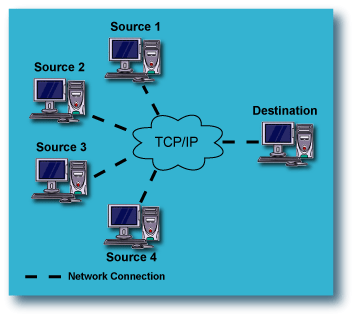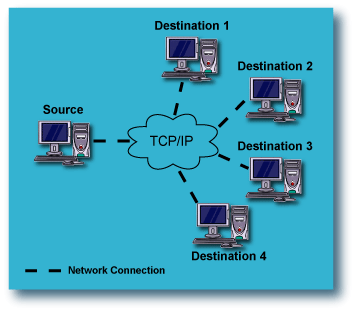Overview
Some of the scenarios of data replication are listed below, but this is not a complete list of all the possible data replication configurations.
Direct Replication
This is the most fundamental configuration for data replication. A single computer on the LAN or WAN has its data replicated to another computer, either local or remote. This provides protection of the source computer against catastrophic failure of the computer itself.

Fan-In Configuration
In a Fan-In configuration, multiple computers on the LAN or WAN have their data replicated to a single computer, either local or remote. This provides protection of all of the source computers against catastrophic failure, while maximizing the use of resources by directing all the data to a single destination computer.
On Windows, most of the configuration of replication and Recovery Point options can be accomplished from the Fan-In tab of the Agent Properties on the destination computer, and these settings are automatically applied to all the source computer. On UNIX, replication and Recovery Point options must be configured on each source computer.
Scalability
Although the scalability of a Fan-In setup can vary based on network and system resources, it is recommended that each Fan-In setup contains no more than 100 source clients.
For maximum performance and robustness, the total number of Replication Pairs configured for the same source volume should be kept to a minimum. If multiple Replication Pairs must be configured for the same source volume, the recommended upper limit is five.
In this configuration for data replication, see How to Setup Fan-In Configuration for more information.
Recovery Points for Fan-In Configurations
Recovery Points created for a Fan-In configuration use VSS or ONTAP as the snap engine for creating snapshots. The use of snap engine is based on the destination being used. When the destination is a fixed volume then VSS is used and when the destination is a filer or iSCSI device then ONTAP is used for the creating snapshots. When destination volume is ONTAP LUN, Use ONTAP snapshot for ONTAP LUN destination option should be selected for creating snapshots with ONTAP snapshot engine. In case if option is not selected, VSS snapshot engine will be used.
Consider the following for ONTAP snapshots:
-
Specify the user authentication details to be used for creating ONTAP snapshots. The user information must be specified both in the General tab of the replication set properties on the source and in the General tab of the agent properties on the destination.
-
Manual mounting of ONTAP snapshots is not supported in a Fan-In configuration. If Auto-mount option is selected, ONTAP snapshots will be automatically shared.
How to Setup Fan-In Configuration
The following section provides the steps required to use CDR for data replication and recovery in a Fan-In configuration based on multiple source computers and a single destination.
-
Install CDR software on all the designated source and destination computer.
Verify that all selected computers meet the System Requirements. For more information see:
Also review the following:
-
Review Destination volume size in Data Replication - Important Considerations and Destination Computer Considerations.
-
The computer selected as the destination for a Fan-In configuration must have Windows 2003 or higher installed if you want to create Recovery Points.
-
Review Log Space Requirements, accounting for the number of source computers that will be sending Replication Logs to the single destination computer.
To configure replicate application data, see Configure CDR to Replicate Application Data.
-
-
On Windows, configure replication and recovery point options. See, Configure Replication and Recovery Point.
-
Note the following:
-
On UNIX, replication and Recovery Point options must be configured on each source Replication Set.
-
On Windows, the options specified in the previous step - configure replication and recovery point options - should not be specified when configuring the Replication Sets, e.g., Recovery Point options should only be set on the Fan-In tab of the destination Agent Properties dialog box, not on the Replication Set Properties dialog box on the source computer.
-
-
For each Replication Set, Add a Replication Pair.
Ensure the following for each Replication Pair:
-
All source computers configured to Fan-In to the same destination computer.
-
Each Replication Pair must use the same destination volume but a different destination path.
-
-
Optionally, configure Throttling.
Note the following:
-
Throttling can be used to allow the destination computer sufficient time to replay the logs it receives from all sources.
On Windows, this can also help prevent the destination from running out of log space.
For Fan-In configurations in particular, it is recommended that you configure the destination computer to start throttling the source computers when its log space runs low. For more information, see Replication Activity Throttling.
-
Configure the Throttling Amount on a source computer to limit the maximum amount of data (in MB/second) it can transfer to the destination, thus preventing a particular source from overwhelming the destination during periods of high I/O.
However, if the source computer is throttled too much, it may not be able to transfer all its Replication Logs quickly enough, and it could run out of space. For more information, see Network Bandwidth Throttling.
-
How to Setup Recovery Points for a Fan-In Configuration
Windows
-
Recovery Points are configured on the destination. These settings will be applied to all Replication Sets for all source computers that use this computer as a destination. See Create a Recovery Point in a Fan-In Configuration for step-by-step instructions.
Recovery Points created for a Fan-In configuration use VSS or ONTAP as the snap engine for creating snapshots. The use of snap engine is based on the destination being used. When the destination is a fixed volume then VSS is used and when the destination is a filer or iSCSI device then ONTAP is used for the creating snapshots. When destination volume is ONTAP LUN, Use ONTAP snapshot for ONTAP LUN destination option should be selected for creating snapshots with ONTAP snapshot engine. In case if option is not selected, VSS snapshot engine will be used.
Consider the following for ONTAP snapshots:
-
Specify the user authentication details to be used for creating ONTAP snapshots. The user information must be specified both in the General tab of the replication set properties on the source and in the General tab of the agent properties on the destination.
-
Manual mounting of ONTAP snapshots is not supported in a Fan-In configuration. If Auto-mount option is selected, ONTAP snapshots will be automatically shared.
-
-
Mount or Unmount the snapshots of a Fan-In Recovery Point, see Mount a Fan-In Recovery Point and Unmount a Fan-In Recovery Point. Note that the snapshots of a recovery point created for a fan-in configuration can be mounted but not shared.
UNIX
Recovery Points are configured on each Replication Set on each source computer. Thus, any Replication Set sharing the same destination can create Recovery Points. For instructions, see Configure Recovery Points and Create a Recovery Point.
For both Windows and UNIX
-
Optionally, you can Configure CDR for Backups of Recovery Points in a Fan-In Configuration.
To perform backups of Recovery Points, you must also install the appropriate file system iDataAgent on the destination computer. Note that you cannot replicate Windows data to a UNIX computer, nor the converse. For the file system iDataAgent installation instructions, see:
-
View the Recovery Point Creation History.
-
Run and review the CDR Copyback Job Summary Report.
Recovering Data for a Fan-In Configuration
Recovering data from Recovery Points or backups of Recovery Points is similar to Recovery Replicated Data. No additional or special steps are required. For more information on recovering data, see Recover Replicated Data. For Copyback procedures, see Copy Back File System Data from a Fan-In Recovery Point.
View the Recovery Point Copyback History.
Run and review the CDR Recovery Job Summary Report.
Fan-Out Configuration
This configuration for data replication, referred to as "Fan-Out", adds significantly to the protection afforded to the source computer, because of the redundancy. A single computer on the LAN or WAN has its data replicated to multiple computers, any of which can be either local or remote. This provides protection against catastrophic failure of an entire site, as well as the source computer itself.

Fan-Out Considerations
Consider the following for Fan-Out configuration:
-
A snapshot of the source volume for each Replication Pair is created during the SmartSync Scan phase, which lead to significant space requirements in a Fan-Out configuration, since a separate Replication Set is required for each different destination. As a simple illustration, if you have 5 destinations for the same source path, thus 5 Replication Sets each having one Replication Pair, 5 snapshots will be created of the source volme. Further, if you have 10 volumes which are each being replicated to those 5 destinations, and you start replication for all of them simultaneously, 50 snapshots will be created during the SmartSync Scan phase. It is recommended in such circumstances to avoid starting all Replication Pairs simultaneously.
-
The VSS cache can be configured using the vssadmin add shadowstorage command from a command line prompt. Refer to Microsoft documentation for details.
-
For Windows, note that since each destination computers communicates with the source computer to indicate when it is finished with a log, a given log will not be automatically deleted on a source computer until all destination computers are finished with it. If one or more destinations are unavailable for any reason, (or planning to be) in Fan-Out scenarios for prolonged period of time, the Replication Pairs for that destination should be aborted, or the source will eventually run out of space as all the replication logs for the offline destination(s) accumulate.